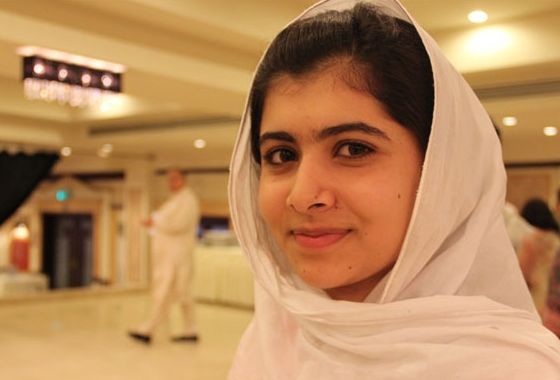
Malala Yousafzai
Marie Brenner writes: One day in November 2007, on an editing console in the Dawn television news bureau in Peshawar, Pakistan, the bright brown eyes of a young girl popped from the computer screen. Just three hours to the northeast, in the Swat Valley, the mountain town of Mingora was under siege. Walking by the desk of the bureau chief, a reporter named Syed Irfan Ashraf stopped to take a look at the edit, which was being translated into English for that night’s news, and heard the girl’s voice. “I’m very frightened,” she said crisply. “Earlier, the situation was quite peaceful in Swat, but now it has worsened. Nowadays explosions are increasing We can’t sleep. Our siblings are terrified, and we cannot come to school.” She spoke an Urdu of startling refinement for a rural child. “Who is that girl?,” Ashraf asked the bureau chief. The answer came in Pashto, the local language: “Takra jenai,” which means “a shining young lady.” He added, “I think her name is Malala.”
The bureau chief had driven to Mingora to interview a local activist, the owner of the Khushal Girls High School & College. On the roads, Taliban soldiers in black turbans pulled drivers out of cars at checkpoints, searching for DVDs, alcohol, and anything else in violation of Shari’a, or strict Islamic law. In a lane near the market, a low wall protected the two-story private school. Inside, the bureau chief visited a fourth-grade class, where several girls shot up their hands when asked if they wanted to be interviewed. Seeing girls speak out in public was very unusual, even in the Swat Valley, a cultivated, 3,500-square-mile Shangri-la with 1.5 million inhabitants. That night, the brown-eyed girl’s sound bite led the news.
Later that evening the bureau chief ran into the school’s owner, Ziauddin Yousafzai, who said, “The girl who spoke on your broadcast. That Malala is my daughter.” The highly educated Yousafzai clearly understood that in the rigid class system of Pakistan he was an invisible member of the rural underclass, unseen by the elite of Lahore and Karachi. For his family, a moment on national news was huge. Like his daughter, Ziauddin spoke excellent English. Ashraf, who had been a professor at the University of Peshawar, could not get the image of Malala’s piercing gaze out of his mind. “She was an ordinary girl, but on-camera extraordinary,” he said. His beat at Dawn television included covering the bombings that were devastating remote villages all through Swat, and he determined to meet Malala and her father the next time he was on assignment in Mingora.
Last autumn, I contacted Ashraf at a computer lab in Carbondale, Illinois, where he is studying for a doctorate in media studies at Southern Illinois University. On October 9, he had seen in a news flash the horrifying image of Malala Yousafzai lying bandaged on a stretcher, after having been shot by an unknown extremist on her school bus. For the next three days, Ashraf did not leave his cubicle as the world grieved for this teenager who had stood up to the Taliban. Then he wrote an anguished column in Dawn, Pakistan’s most widely read English-language newspaper, which seemed like a profound mea culpa. Ashraf was savage regarding his role in Malala’s tragedy. “Hype is created with the help of the media while the people wait for the dénouement,” he wrote. He decried “the media’s role in dragging bright young people into dirty wars with horrible consequences for the innocent.” On the telephone he told me, “I was in shock. I could not call anyone.” He described his mute agony watching the TV coverage. “It is criminal what I did,” he said in an apoplectic tone. “I lured in a child of 11.” [Continue reading…]

